|
This section contains 11,076 words (approx. 37 pages at 300 words per page) |

|
SOURCE: Axelrod, Mark. “The Poetics of Peripatetics and Peripety in Hamsun's Hunger.” In The Poetics of Novels: Fiction and Its Execution, pp. 140-70. London: Macmillan, 1999.
In the following essay, Axelrod examines the use of space, travel, movement, and change in Hunger.
Published in 1890, Hunger is probably Hamsun's best known and, arguably, his best written novel. Sizeably autobiographical, it deals with the time Hamsun existed in Kristiania (Oslo) and is extraordinary in terms of psychological depth and poetic temperament. But one cannot easily dismiss the effect starvation had on Hamsun and to that extent one cannot discount intentionality. As Robert Ferguson writes of Hunger in his biography, Enigma: The Life of Knut Hamsun: ‘In writing it he drew on the experiences he underwent during his two most desperate periods in Kristiania in the winters of 1880-81 and 1885-86, and probably, also drew on the experiences of his winter in...
|
This section contains 11,076 words (approx. 37 pages at 300 words per page) |

|


